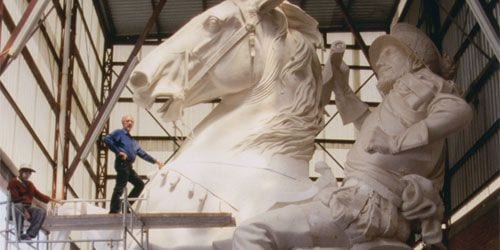
And what will our memory be of the Middle East? Latin America? That we brought violence and destruction to thousands of innocent people in the name of Holy Oil? Maybe. Maybe not. More likely, what the memory will be is our heroic efforts to take Christianity, freedom and democracy to godless people. The point is, what we may know only is what is presented to us. In time lies and half truths do become the truth; if we let it.
— Maurus Chino, “Oppression Affects All People,” 2006
Everybody’s been screwed, let’s face it. When you go back far enough, what people hasn’t been by some other people? It would seem to the nature of our species, wouldn’t it?
— John Houser
John Sherrill Houser is an artist who, like many artists before him, believes he has a vision. Advised that his work is beautiful and important, he was grateful, if not precisely humbled, to be asked to commemorate the history of El Paso, Texas. His concept, The XII Travelers Memorial, is surely grand, even gargantuan. With his own predecessors and future reputation in mind, he decides to create a dozen larger-than-life bronze figures, arranged through the city’s downtown area, so “We could have it like a statue walk through history.”
As recounted in John J. Valadez and Cristina Ibarra’s documentary The Last Conquistador, premiering on PBS’ POV 15 July, Houser’s plan ran into trouble with its second figure. After completing the 15-foot high Fray García de San Francisco, Founder of the Pass on the North, 1659, the sculptor proposed a 36-foot high equestrian statue, a monument to El Paso, Houser, and its explicit subject, the 16th-century Spanish conquistador Don Juan de Oñate. As Houser describes his intention to “recognize the grandeur of Don Juan de Oñate and Spanish exploration into the southwest that eventually created Hispanic America,” the camera shows a worker on the project, his appearance suggesting his relation to that particular “America,” as well as another America, that of the natives who inhabited the area before it was claimed and renamed. Houser continues, underscoring his investment in the project: “There are certain qualities that [Oñate] had that I imagine are also necessary for a sculptor to have to do this kind of a project. You have to have a vision, you have to have a goal, and you have to have a determination to do it no matter what.”
It’s this particular “no matter what” that comes to shape the Oñate memorial in ways that neither its maker nor the City Council members who approved the project do not anticipate. Council member Larry Medina says, “The first thing that came to our minds was tourism.” With El Paso being “the 10th poorest city in America,” the Council hoped that investing close to $1 million in art would help to improve the economy. The Oñate statue, six years in the making, became a source of controversy: like other conquistadors, he claimed land in the name of his kingdom and committed atrocities to make that claim stick. As linguist and historian Lana Harrigan recounts, “When they reached San Juan Pueblo, Oñate had the Indians kicked Indians out of their homes and the Spaniards were requisitioning food from all of the surrounding pueblos, so the Indians were very, very disgruntled.” Her understatement is telling, especially as the film reveals the rest of the story. Historian and human rights activist Roxanne Dunbar-Ortiz describes the systematic massacre of Indians, hacked to death and fed to the Spaniards’ dogs.
Methodically and cleverly, The Last Conquistador follows the controversy surrounding the statue. Houser, whose father was an assistant sculptor on Mt. Rushmore, asserts that it commemorates the past without judgment (“Sure, Oñate had his faults and maybe he did commit this atrocity at Acoma, but he represented a relatively different period so it’s not for me to defend him or to accuse him”), while protestors see connections between past violence and present tributes. Dunbar-Ortiz notes a continuum linking murder, rape, and desecration to Christianization as a process of oppression, assimilating a native culture into the invading one; Maurus Chino, founder of the Indigenous Truth Alliance, insists, “There has to be a recognition of what really happened in this area.”
The film lays out some unsubtle race and class conflicts: at a fundraising garden party, wealthy donors learn over drinks that Oñate “was not politically correct,” try on conquistador helmets and write out checks (“He sort of ravaged the countryside,” says one organizer, before pointing to a model on display: “But look at the detail in this: isn’t that beautiful?”). At the same time, Council member Anthony Cobos embodies a particular tension, initially supporting the project until he learns specifics. Being both Hispanic and Native American, he says he feels “torn, like most Hispanics should be.”
As it explores the functions and effects of public art, the documentary finds a convenient sort of metaphor in Houser himself. He has developed glaucoma, and his visits to the ophthalmologist provide poignant images of flawed and failing vision. The resonance is not lost on the artist, and he is visibly moved by protestors’ rage and tears. He too is “torn,” saddened by the upset caused by his work but proud of the work in its abstract, ahistorical hugeness. Historian David Romo describes its offenses with regard to art as well as accuracy, as it displays Oñate “at this Disneyfied and McDonaldsized level, without seeing the guys and gore of history.” Though Houser comes to see the historical crimes, he cannot see the current oppression represented by the statue. His dedication of the statue to both “the struggle of indigenous people and to that small group of intrepid colonists” equates invaders and victims. It’s a blindness afforded only to select beneficiaries of history.

![Call for Papers: All Things Reconsidered [MUSIC] May-August 2024](https://www.popmatters.com/wp-content/uploads/2024/04/all-things-reconsidered-call-music-may-2024-720x380.jpg)



